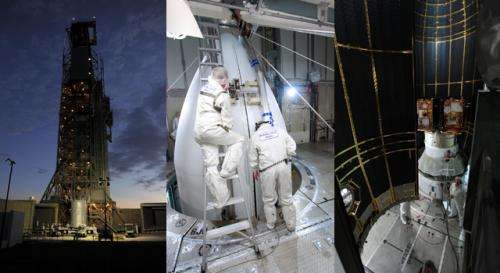GRAIL mission to launch today

(PhysOrg.com) -- NASA's GRAIL spacecraft are set to launch to the moon aboard a United Launch Alliance Delta II rocket on Sept. 8, 2011, from Cape Canaveral Air Force Station, Fla. There are two instantaneous (one-second) launch windows at 5:37:06 a.m. and 6:16:12 a.m. PDT (8:37:06 a.m. and 9:16:12 a.m. EDT). The launch period extends through Oct. 19. The launch times occur approximately four minutes earlier each day.
GRAIL's primary science objectives are to determine the structure of the lunar interior, from crust to core, and to advance understanding of the thermal evolution of the moon.
The lunar orbiters are nestled inside the top of a United Launch Alliance Delta II 7920H-10C rocket, the most powerful Delta rocket in NASA's inventory.
On launch day, Sept. 8, NASA TV commentary coverage of the countdown will begin at 3 a.m. PDT (6 a.m. EDT). The coverage will be webcast at www.nasa.gov/ntv . Live countdown coverage on NASA's launch blog also begins at 3 a.m. PDT (6 a.m. EDT) at www.nasa.gov/mission_pages/gra … unch/grail_blog.html . Coverage features real-time updates of countdown milestones, as well as streaming video clips highlighting launch preparations and liftoff.
The launch will also be online, with a live chat available, on Ustream TV, at www.ustream.tv/nasajpl2 .
Here is a timeline of expected launch milestones:
Launch
At liftoff, the rocket's first-stage engine and six of its nine strap-on solid rocket motors will ignite, and the rocket will be airborne, carrying GRAIL up and over the Atlantic Ocean.
First six solid rocket motors are jettisoned
GRAIL's Delta II is carrying nine strap-on graphite-epoxy motors. The first six will be ignited at the time of liftoff. The remaining three will be ignited shortly after the first six strap-on motors burn out.
Fairing separates
After the Delta's first stage completes its tour of duty, its second stage, which will provide 9,645 pounds of kick for GRAIL, will begin the first of two scheduled burns.
Shortly after ignition of the rocket's second stage, the Delta's 30-foot-long (8.88-meter-long) nose cone, or fairing, will separate and be jettisoned as planned, providing the GRAIL twins with their first taste of exo-atmospheric existence.
Parking at 17,500 miles per hour
The Delta's second stage will temporarily stop firing, as planned, and the rocket and GRAIL will begin a planned coast phase, also known as a "parking orbit" at about 90 miles (nearly 167 kilometers up).
GRAIL heading from Earth to the moon
The Delta's second stage will begin a second burn. This approximately four-and-a-half-minute-long burn will place GRAIL on its desired trajectory to the moon.
Spacecraft begin to separate from second stage
The GRAIL-A spacecraft begins its separation process from the Delta's second stage. The GRAIL-B spacecraft separates about 8 minutes later. At this point, the moon is three-and-a-half months away.
Provided by JPL/NASA




















